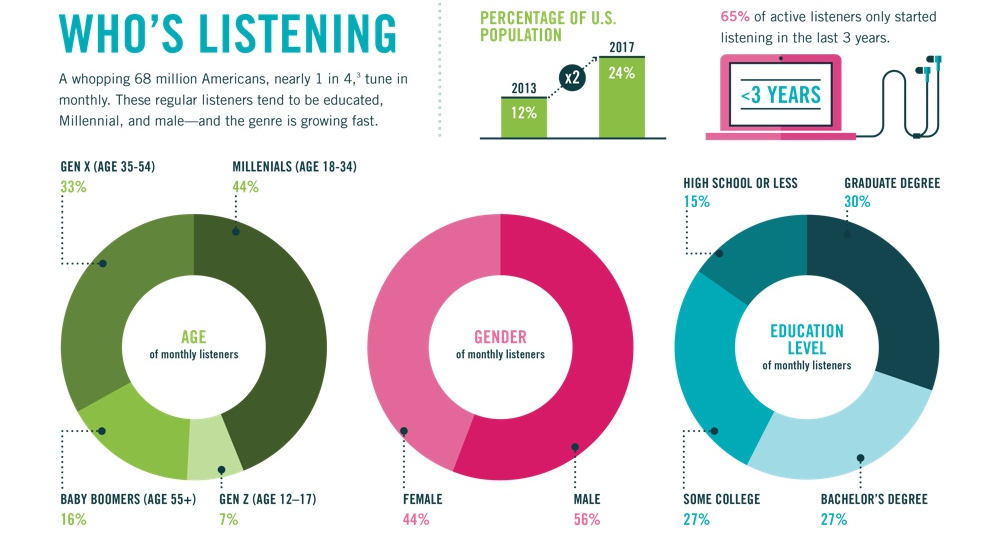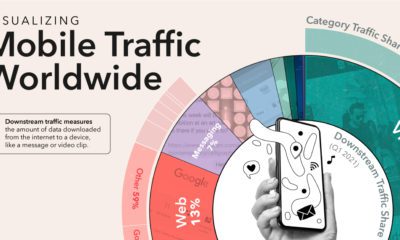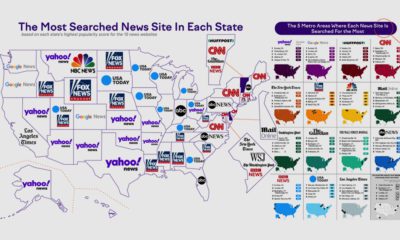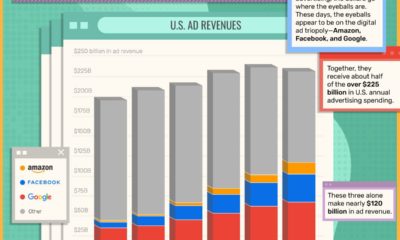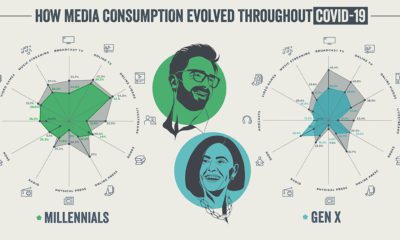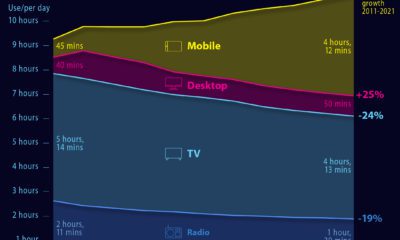The most seismic shift has been to the media landscape as platforms like Facebook overtake traditional channels of news, distribution, and advertising. Not only does this put incumbent news conglomerates in an unenviable position, but it has also thrust tech companies into the reluctant role of the gatekeeper for society’s most important news and information. While people may be divided on whether this is good or bad, there is another major change stemming from technology that is more clean cut in having a positive effect on consumers. The internet has allowed the news and content we consume to migrate away from centralized and capital-intensive sources (radio shows, cable TV), opening up many new and digestible formats of storytelling that were never before imaginable. The barrier of entry for content has dropped towards zero, and it allows for many different “laboratories” to test new ideas, formats, and concepts until the winners are found.
New Formats to Experience
We are obviously advocates of the growing role of the visual medium for storytelling, which we aim to do mainly through infographics and data visualizations. While people have used visual storytelling since the cave drawing days, technology has really allowed this medium to hit a new stride as a way to break through the clutter. Further, science says that people crave visual content, and infographics provide a shareable, intuitive, distilled, and thought-provoking approach to sharing data. Like infographics, the podcasting format – which is the subject of today’s post from Concordia University – has also recently began hitting a sweet spot for audiences around the world. This convenient audio format has been made possible through technology, and doesn’t rely on the same entrenched distribution channels as old school formats, such as radio. As a result, podcasters can experiment more with the structures of their craft, while avoiding traditional forms of censorship. Today’s podcasts are breaking new ground daily with unique content that falls anywhere on the spectrum, from improvisational comedy to fact-dense educational features.
The Podcasting Boom
The podcast, a name originating from a portmanteau of “iPod” and “broadcast”, was first coined in 2004 by journalist Ben Hammersley of the BBC and The Guardian. Despite being a feasible form of content even during the age of MP3 players and early broadband connections, the format has only really hit the mainstream in recent years. It’s hard to explain why, but most experts point to increased mobility, better production value, and a group of content creators that have recently managed to capture the imagination of the broader public. Regardless, in recent years, the podcasting space has boomed to new levels of popularity. Today, the percentage of Americans that listen to podcasts is 24%, which is double what it was in 2013. Further, the advertising market for podcasts is growing as well. In 2015, the ad market for podcasts was $69 million – but by 2017, the market was triple the size at an estimated $220 million. Podcasts allow advertisers to tap into very specific audience psychographics, and podcasts offer higher CPMs ($25-45) for successful publishers than traditional online content ($1-$20).
When and Where?
Aside from allowing new types of content to blossom outside of traditional distribution channels, podcasting has one other defining characteristic: mobility. Just as streaming does for video, podcasts allow audio to be played in many situations where it was previously less feasible for a user to curate content. In fact, people listen to podcasts the most while driving (52%), traveling (46%), walking, running, or biking (40%), commuting on public transportation (37%), and while working out (32%). This carves a pretty interesting niche that video and other content types can’t fill. And if podcasting content keeps getting better, people may even opt to listen in at other times outside of travel, building out the medium to even bigger heights. on But fast forward to the end of last week, and SVB was shuttered by regulators after a panic-induced bank run. So, how exactly did this happen? We dig in below.
Road to a Bank Run
SVB and its customers generally thrived during the low interest rate era, but as rates rose, SVB found itself more exposed to risk than a typical bank. Even so, at the end of 2022, the bank’s balance sheet showed no cause for alarm.
As well, the bank was viewed positively in a number of places. Most Wall Street analyst ratings were overwhelmingly positive on the bank’s stock, and Forbes had just added the bank to its Financial All-Stars list. Outward signs of trouble emerged on Wednesday, March 8th, when SVB surprised investors with news that the bank needed to raise more than $2 billion to shore up its balance sheet. The reaction from prominent venture capitalists was not positive, with Coatue Management, Union Square Ventures, and Peter Thiel’s Founders Fund moving to limit exposure to the 40-year-old bank. The influence of these firms is believed to have added fuel to the fire, and a bank run ensued. Also influencing decision making was the fact that SVB had the highest percentage of uninsured domestic deposits of all big banks. These totaled nearly $152 billion, or about 97% of all deposits. By the end of the day, customers had tried to withdraw $42 billion in deposits.
What Triggered the SVB Collapse?
While the collapse of SVB took place over the course of 44 hours, its roots trace back to the early pandemic years. In 2021, U.S. venture capital-backed companies raised a record $330 billion—double the amount seen in 2020. At the time, interest rates were at rock-bottom levels to help buoy the economy. Matt Levine sums up the situation well: “When interest rates are low everywhere, a dollar in 20 years is about as good as a dollar today, so a startup whose business model is “we will lose money for a decade building artificial intelligence, and then rake in lots of money in the far future” sounds pretty good. When interest rates are higher, a dollar today is better than a dollar tomorrow, so investors want cash flows. When interest rates were low for a long time, and suddenly become high, all the money that was rushing to your customers is suddenly cut off.” Source: Pitchbook Why is this important? During this time, SVB received billions of dollars from these venture-backed clients. In one year alone, their deposits increased 100%. They took these funds and invested them in longer-term bonds. As a result, this created a dangerous trap as the company expected rates would remain low. During this time, SVB invested in bonds at the top of the market. As interest rates rose higher and bond prices declined, SVB started taking major losses on their long-term bond holdings.
Losses Fueling a Liquidity Crunch
When SVB reported its fourth quarter results in early 2023, Moody’s Investor Service, a credit rating agency took notice. In early March, it said that SVB was at high risk for a downgrade due to its significant unrealized losses. In response, SVB looked to sell $2 billion of its investments at a loss to help boost liquidity for its struggling balance sheet. Soon, more hedge funds and venture investors realized SVB could be on thin ice. Depositors withdrew funds in droves, spurring a liquidity squeeze and prompting California regulators and the FDIC to step in and shut down the bank.
What Happens Now?
While much of SVB’s activity was focused on the tech sector, the bank’s shocking collapse has rattled a financial sector that is already on edge.
The four biggest U.S. banks lost a combined $52 billion the day before the SVB collapse. On Friday, other banking stocks saw double-digit drops, including Signature Bank (-23%), First Republic (-15%), and Silvergate Capital (-11%).
Source: Morningstar Direct. *Represents March 9 data, trading halted on March 10.
When the dust settles, it’s hard to predict the ripple effects that will emerge from this dramatic event. For investors, the Secretary of the Treasury Janet Yellen announced confidence in the banking system remaining resilient, noting that regulators have the proper tools in response to the issue.
But others have seen trouble brewing as far back as 2020 (or earlier) when commercial banking assets were skyrocketing and banks were buying bonds when rates were low.
